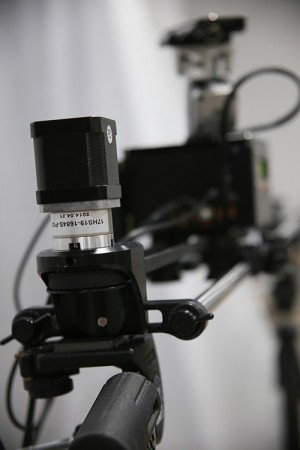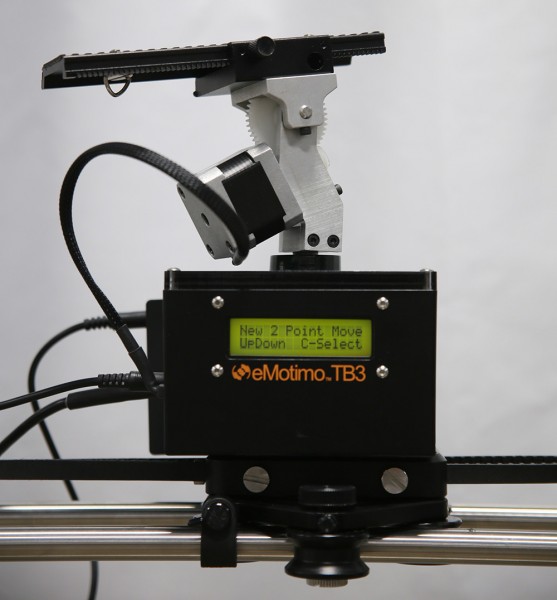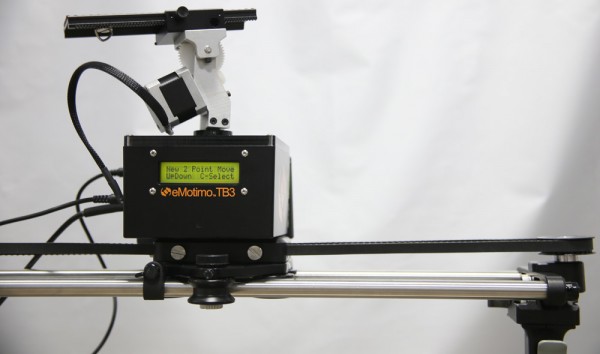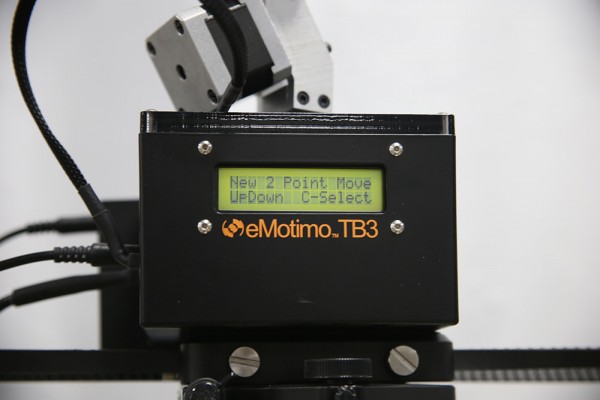 Manufacturer: eMotimo and Rhino Camera Gear
Manufacturer: eMotimo and Rhino Camera Gear
Website: emotimo.com and rhinocameragear.com
Description: 3-axis programmable camera robot with 4’ slider
Purchase/Rent: Purchase
Pricing: $2,000 as tested ($999 for head, $800 for slider, some extras were used in review kit)
Expected Release: Available Now
Reviewed By: Paul Schmutzler
Final Score: 9 out of 10
The eMotimo TB3 Black is a 2-axis Mo-Co robotic system that can be controlled live with a wired or wireless controller or be programmed to run a 2-point or 3-point move. eMotimo (San Francisco, CA) and Rhino Camera Gear (Puyallup, WA) teamed up earlier this year to take two of their products and marry them, adding the third axis of programmable motion. With an extra motor, a toothed belt and Rhino’s 4’ rail slider, camera operators can now pan, tilt and slide their way to dynamic imagery.
 Doing this in a consistent, repeatable and jitter-free way is vitally important, but achieving those results on a small budget has been a challenge.
Doing this in a consistent, repeatable and jitter-free way is vitally important, but achieving those results on a small budget has been a challenge.
Read on to see if the TB3 and Rhino slider rise to meet both challenges adequately.
EASE OF USE
The physical setup of the TB3 and slider is dead simple. You can choose to keep the slider on the ground or a table by using the attached, adjustable rubber feet. Removing the provided wing nuts will allow you access to the standard ¼”-20 tripod slot. Grab your plates to screw them on, and you’re ready to raise your camera height or even do vertical moves.
Routing the belt is self-explanatory. One end goes around an idler; the other goes through a motor. Motors are available in different ratios from 5:1 up to 27:1. The lower numbers are good for higher speed, lower torque. For flat moves requiring higher speed, the 5:1 motor is the way to go. For inclines or with heavier gear, a 27:1 motor will provide enough muscle to not stall during your shot. Note that eMotimo has a recommended weight limit of 5 pounds for the TB3, but founder and CEO Brian Burling told me that some producers are using rigs as large as RED Digital Cinema Cameras on their heads without any trouble. The physical setup of the entire system should take 2-3 minutes with a little bit of experience.
Once the TB3 has been screwed onto the rail system, you can power it up and connect the controller. The menu system is fairly straightforward. However, navigating the “Setup” menu can be a little unclear without going to eMotimo’s site to read up on what each item means. For example, I had a move setup that included an incline. I had the strong 27:1 motor installed, but the head kept falling back downhill as it tried to accomplish the move. I found that I needed to change the motor’s power setting in the “Setup” menu in order for the motors to not shut off between actions.
The steps for setting up a programmed move are simple. You choose a start and end position by using the joystick and rotating the accelerometer-equipped controller. You then choose your move duration (in H:M:S format), ramping amount (in frames) and start delay. After completing your settings, the head moves to the start position and waits for the command to proceed. After completing a move, it can be performed in reverse or re-run from the beginning by using the “C” or “Z” buttons on the controller. Setting up a programmed move usually took me two minutes or less.
DEPTH OF OPTIONS
As a product kit, the eMotimo TB3 Black and Rhino slider is designed to do just one thing: move an attached camera from point A to point B (alternately A>B>C) smoothly and in a designated amount of time. Practically, the system can be used in many more ways. Programming a move and allowing the TB3 to control the motion is definitely the best course of action when possible. You get perfectly predictable results that can repeated over and over. That’s probably why the TB3 has gained such a following among the timelapse and visual effects crowds.
Using the TB3 in a real-time control mode is certainly an option, although perhaps not as elegant as pre-programmed. Considering you’re using a controller that is designed for a Nintendo Wii, you can imagine how the sensitivity can become an obstacle to smooth control. In my tests, I found it difficult to get used to where the thresholds were for each axis of motion as I tried to move my camera to track moving subjects. And trying to move multiple axes at once will be problematic as the motors won’t operate at their full speed when running concurrently.
PERFORMANCE
I tested the TB3 and Rhino slider out in several production environments. I shot timelapse with my DSLR both indoors and out on location. I took the kit to a zoo where I setup pre-programmed moves with other patrons around. I took it to a remote national park and shot a kayaker navigating the rapids of the Obed Wild and Scenic River. In each situation, I tried different lenses on the camera, different balancing, and different moves.
Basic side-to-side/pan-tilt moves work the best. Any move involving vertical motion takes more planning and care to be successful, but I found those moves to be the most satisfying when done right. After using the products for over a month, I only had two failed moves. These happened when the move being requested required too much power or speed for the motor to handle. Stronger motors would be an easy fix for this in future versions.
VALUE
What the TB3 and Rhino slider can accomplish is rivaled only by systems much more complex and expensive. Those wanting to compete within the same price range as eMotimo have similar products in the works, but they are still in development. For now eMotimo has hit a sweet spot for multi-axis camera control that fits the budget of microbudget and short filmmakers. Getting 2 axes of motion for $1,000 or 3 axes for $2,000 is an attractive deal for even the most frugal producer.
FINAL COMMENTS
The eMotimo TB3 alone is a very capable and well-built robotic head for your camera. The compact, industrial design can be comfortably added to a stable of production equipment with a small commitment in cost, space and weight. There are some small improvements that can and should be made to the hardware design, but these are expected with a first-generation product. The addition and integration of the Rhino 4’ slider gives an added dimension of motion that can rival jibs and cranes in some cases. If you’re interested in saving money and adding an unmanned second camera angle to your productions, the TB3 and Rhino slider from eMotimo is worth your attention.
|
Breakdown
|
|
|
Ease of Use
|
7.0 |
|
Depth of Options
|
9.0 |
|
Performance
|
9.8 |
|
Value vs. Cost
|
10.0 |
|
Overall Score |
9.0 |



